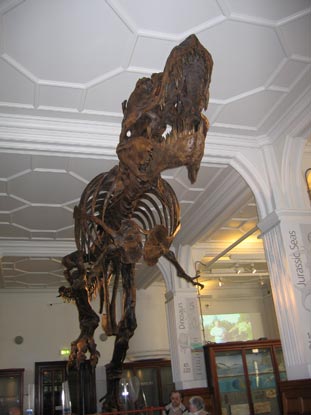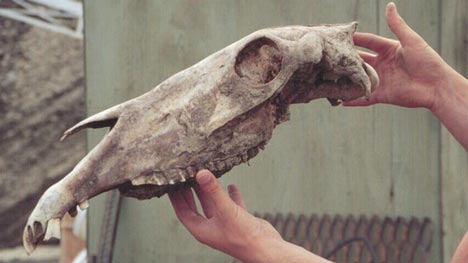Dinosaurs – The Hunt for Life
Horizon, the documentary series regarded by many as the flagship science programme for the BBC is venturing into the world of the dinosaurs once again with a programme dedicated to the remarkable work of Dr Mary Schweitzer and her colleagues. Scientists have had the fossilised bones of dinosaurs to study and over the last one hundred and eighty years or so much has been learned about these long extinct reptiles, but could there be more than just permineralised, long-dead material present in the fossils of dinosaurs? Could biological material such as cells, soft tissue, blood and possibly DNA from dinosaurs still exist?
The Hunt for Dinosaur DNA
Picture credit: Everything Dinosaur
Dinosaur DNA
On Monday 26th September at 9pm (BST) on BBC2, Horizon will focus on the work of Dr Schweitzer who believes that soft tissues and other organic material has been recovered from deep inside the long, dead bones of iconic animals such as Tyrannosaurus rex. Perhaps the idea of a Jurassic Park such as the one envisaged by the author Michael Crichton will one day be more than fiction, could the research carried out by scientists such as those at the North Carolina State University lead to the resurrection of some members of the Dinosauria?
DNA Defined
DNA is deoxyribonucleic acid, a molecule of genetic material that determines the inherited characteristics of most living organisms. The vast majority of examples of the DNA molecule consist of a double helix made up of two long chains which are made up of nucleotides, these in turn are made up from 4 proteins referred to as nucleobases (thymine, guanine, adenine and cytosine) represented by the letters T, G, A, and C. Almost every cell of every organism from many viruses, amoebas, dinosaurs and humans has its own set of molecular instructions. The function of each cell is encoded in the chromosomes, these carry the hereditary data in the form of genes.
On this blog, team members at Everything Dinosaur have reported on a number of studies that claim that organic material has been recovered from the fossil record, although many scientists have been sceptical about such research. Mary made the initial discovery of T. rex soft tissue remains back in 2005, since then she has argued that organic material may actually be relatively common in well-preserved, robust fossils, but since very few people expected to find such material, it has been rather overlooked. Mary and her team are not alone when it comes to exploring the soft tissues of extinct animals.
Montana State University has pioneered research into ancestral DNA through the study of bird embryos, confirming a now, well established view that Aves (birds) and the Dinosauria, especially Theropoda are very closely related.
One of Dr Schweitzer’s co-authors on a number of soft tissue studies, Assistant Professor of Medicine at Harvard Medical School John Asara agrees with Mary, that there may be more organic material awaiting discovery. He has been working on a number of projects related to the study of fossilised proteins, which have reaffirmed the dinosaurs close affinity to the birds.
To read a short article on this work: Are You Going to Call T. rex Chicken?
Scientists Challenge the Findings
A number of scientists and other academics have challenged these studies. It had been thought that DNA could not survive more than 10,000 years. It, like all other organic material would be rapidly degraded and broken down unless it was subjected to a very unusual manner of preservation, such as being entombed in ice, for example in the case of Woolly Mammoth remains from Siberia. In 2012, Everything Dinosaur reported on a piece of highly controversial research carried out on the fossilised bones of the Moa (a giant, flightless bird that once inhabited New Zealand).
Analysis of the robust bones of three extinct species of New Zealand Moa by a team of international researchers led to the publication of the estimated half-life of DNA. Under the very best conditions for preservation, it was calculated that the proteins that make up DNA could persist in the fossil record and permit detectable traces still to be found in fossils as old as 6.8 million years.
Controversial research suggests a half-life for DNA: Calculating the Half-life of DNA using Moa Fossils.
Still to recover DNA from a Tyrannosaurus rex would require DNA to remain preserved, uncontaminated and viable for nearly ten times as long. After all, the last T. rex went extinct around sixty-five million years ago.
Could what the suggests have found preserved in the fossilised bones of dinosaurs, be organic material from another source? Tests have shown that some of the material recovered reacts in the same way as organic material from birds. Is there contamination? How can the delicate organic material such as blood, collagen and proteins be preserved for so long? Do the tiny, microscopic fragments recovered really represent organic material from a long dead dinosaur?
Intriguingly, animals very far removed from Tyrannosaurus rex have lent support to Schweitzer’s and Asara’s claims. Researchers from the University of Copenhagen (Denmark), co-authored a paper that was published in the journal “Nature” about a study to sequence a portion of the ancestral horse genome from an equine fossil that was more than 700,000 years old. The research dramatically extended the limit for viable DNA survival in the fossil record. Recently, a fragment of a tibia (lower leg bone), recovered from 3.5 million year old deposits on Ellesmere Island (Canada) was proved to belong to an ancient camel, thanks to collagen finger printing carried out by University of Manchester scientists.
Recently Published Studies Push Back the Date of Viable Genetic Material from the Fossil Record
Picture credit: D.G. Froese/Nature Journal
The horizon programme will focus on the research into dinosaur DNA, however, the implications of this soft tissue recovery will have far reaching consequences and may well lead to a reappraisal of what we do and don’t know about a whole host of extinct fauna.
Watch and enjoy.
To read a related article on the extraction of dinosaur proteins from an ornithischian dinosaur: The Search for Proteins in the Femur of a Duck-Billed Dinosaur.








That has to be one if the worst documentaries I have ever seen. Padded out with virtually nothing.
I think you have hit the nail on the head. It left us all rather underwhelmed. So much to explore in terms of the developments in molecular biology and its application in palaeontology, but what was covered was very superficial and then we had the issue of fossil smuggling out of Mongolia tacked onto the end. All in all a little disappointing and we had expected so much more from what many of us regards as one of the BBC’s flagship science programmes.
We had the same opinion. I think they’re trying to make science more accessable, but end up completely missing the point.
Apart from being a massive anticlimax, the programme itself was terrible, with endless repeats of the same footage. If you took out the clips of ‘torches around the dinosaur skeleton’, the endless twisting of the malleable bone, the microscopic tearing of the tissue and the pointless jaunt into the Gob desert, there would be around 10mins of programme content.
Quite agree, it was so disappointing.
The programme was remarkable in that it stated categorically that dinosaurs were birds. “…for modern scientists the teeth are seen as a distraction. A more comprehensive analysis of their skeletons suggests that they’re not related to lizards but birds.” Jack horner was brave enough to compare Tyrannosaurus Rex to a vulture and to state that dinosaurs probably moved in unison like birds. Mary Schweitzer compared an ostrich wing to a T-Rex arm and when attacked by a large wading bird, she said it was her “Velociraptor moment.”
Is not modern science leaning more closely to the view that all of the bipedal dinosaurs were actually flightless birds? The residual toe attached to the ankle of the bipeds is the absolute proof of a bird foot which is in the process of adapting to one that is suitable for living on land. It is clear that their ancestors used to roost in trees. This website could lead the charge in changing long held perceptions of these fascinating creatures.
I noticed that you referred to scientists suggesting an evolutionary link between dinosaurs and birds. It is an assertion which really got me thinking. I like what Robin and Honey Badger have to say on this topic:
“Originating from an ancestor is not the same as being that ancestor. Evolution is about one organism evolving from another, not one organism remaining another.”
For example, snakes evolved from primitive lizards but it would be absurd to claim that snakes are lizards.
http://www.explorebioedge.com/bio-bullets/item/79-are-birds-really-avian-dinosaurs.html
Whether its classical Linnaean approach based on nested hierarchies or a cladistic model that is used, there are very strong taxonomic affinities between members of the Order Dinosauria such as Maniraptorans and Aves. The fossil evidence suggests a strong evolutionary link between Theropod dinosaurs and birds, even the Neornithes. The example used referring to snakes and lizards is a good way to illustrate the point being made related to evolution, but it is also valid to state that both lizards and snakes belong to the same Order, the Squamata.
If we ever find DNA from a dinosaur closely related to birds such as a Velociraptor, then maybe we could piece the various found fragments together and get the whole genome. And if that’s possible, then maybe we could take Jack Horner’s dinochicken mutant and fertilize its oocyte with Velociraptor DNA, creating a Velociraptor-dinochicken hybrid. This embryo could be inserted into the uterus of a dinochicken, and an egg shell would form around it. The adult animal could have the reproductive organs of a Velociraptor, so we could clone a velociraptor using it. After this we could use the velociraptor to clone something less closely related to birds, and eventually we could recreate something as far away from birds as a T. Rex or a Saltasaurus.
And in regards to non-avian dinosaur DNA, didn’t Schweitzer report that iron is capable of preserving proteins for tens of millions of years, as far back as the Jurassic, and therefore possibly DNA too?
Just my thoughts.
The paper reporting this was from November of last year, I believe.
I also figured that we would make the chromosomes using knowledge of such in living birds and reptiles.
Thanks for your input, much appreciated.